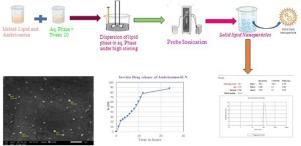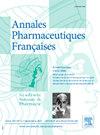Sustained release of Ambrisentan solid lipid nanoparticles for the treatment of hypertension: Melt emulsification method
IF 1.1
Q4 PHARMACOLOGY & PHARMACY
引用次数: 0
Abstract
Objective
The beneficial usefulness is limited because of its deprived solubility and bioavailability. The recent work deals with the advancement of solid lipid nanoparticles of Ambrisentan for the effective therapy of pulmonary hypertension intended for oral delivery.
Material and methods
The solid lipid nanoparticles of Ambrisentan were developed using the melt emulsification method. The characterization of Ambrisentan was carried out with FTIR, DSC, and crystalline nature with XRD. The optimization was accomplished with the Box-Behnken design. The glyceryl monostearate (GMS), Tween 80, and sonication time were considered independent factors and the particle size, and entrapment efficiency were the critical quality attributes in the development of SLN.
Results
The compatibility, thermal nature, and crystalline behavior were confirmed with FTIR, DSC, and XRD respectively. The preferred batch F10 indicated a particle size of 166.7 nm and an entrapment efficiency of 83.96%. The cumulative percentage of drug dissolved from the optimized Ambrisentan-loaded SLN was 87.68% after 24 h indicating a sustained release pattern. Furthermore, after lyophilization and estimated with scanning electron microscopy a particle size of 153.5 to 179.8 nm was confirmed. The lyophilized powder is intended for oral delivery and has significant bioavailability, minimizing the chances of mortality due to its sustained release action.
Conclusion
The significant improvement in solubility of Ambrisentan was achieved through solid lipid nanoparticles which facilitates greater efficacy.
Objectif
L’utilité bénéfique est limitée en raison de sa solubilité et de sa biodisponibilité limitées. Les travaux récents portent sur l’avancement des nanoparticules lipidiques solides d’Ambrisentan pour le traitement efficace de l’hypertension pulmonaire destinée à être administrée par voie orale.
Matériel et méthodes
Le développement de nanoparticules lipidiques solides d’Ambrisentan a été réalisé par la méthode d’émulsification en fusion. La caractérisation de l’Ambrisentan a été réalisée par FTIR, DSC et nature cristalline par XRD. L’optimisation a été réalisée avec la conception Box-Behnken. Le monostéarate de glycéryle (GMS), le Tween 80 et le temps de sonication ont été considérés comme des facteurs indépendants, tandis que la taille des particules et l’efficacité du piégeage étaient les attributs de qualité critiques dans le développement du SLN.
Résultats
La compatibilité, la nature thermique et le comportement cristallin ont été confirmés respectivement par FTIR, DSC et XRD. Le lot préféré F10 indiquait une taille de particule de 166,7 nm et une efficacité de piégeage de 83,96%. Le pourcentage cumulé de médicament dissous à partir du SLN optimisé chargé en Ambrisentan était de 87,68% après 24 h, ce qui indique un modèle de libération prolongée. De plus, après lyophilisation et estimation par microscopie électronique à balayage, une taille de particule de 153,5 à 179,8 nm a été confirmée. La poudre lyophilisée est destinée à une administration orale avec une biodisponibilité significative et minimise les risques de mortalité grâce à son action de libération prolongée.
Conclusion
L’amélioration significative de la solubilité de l’Ambrisentan a été obtenue grâce à des nanoparticules lipidiques solides, ce qui facilite une plus grande efficacité.

氨布里森坦固体脂质纳米颗粒治疗高血压的缓释:熔融乳化法。
目的:由于其溶解度和生物利用度不足,限制了其有益作用。最近的工作涉及固体脂质纳米粒Ambrisentan用于有效治疗肺动脉高压的口服给药的进展。材料与方法:采用熔融乳化法制备氨布里森坦固体脂质纳米颗粒。用FTIR、DSC和XRD对Ambrisentan进行了表征。优化是通过Box-Behnken设计完成的。单硬脂酸甘油酯(GMS)、Tween 80和超声时间被认为是独立因素,粒径和包埋效率是SLN开发的关键质量属性。结果:分别用FTIR、DSC和XRD对其相容性、热性质和结晶行为进行了表征。优选批次F10的粒径为166.7 nm,包封效率为83.96%。24 h后,载安布里森坦SLN的药物溶出率为87.68%,呈缓释模式。此外,经冻干和扫描电镜估计,证实颗粒尺寸为153.5 nm至179.8 nm。冻干粉用于口服,具有显著的生物利用度,由于其持续释放作用,最大限度地减少了死亡的机会。结论:固体脂质纳米颗粒可显著提高氨布里森坦的溶解度,提高其治疗效果。
本文章由计算机程序翻译,如有差异,请以英文原文为准。
求助全文
约1分钟内获得全文
求助全文
来源期刊

Annales pharmaceutiques francaises
PHARMACOLOGY & PHARMACY-
CiteScore
1.70
自引率
7.70%
发文量
98
期刊介绍:
This journal proposes a scientific information validated and indexed to be informed about the last research works in all the domains interesting the pharmacy. The original works, general reviews, the focusing, the brief notes, subjected by the best academics and the professionals, propose a synthetic approach of the last progress accomplished in the concerned sectors. The thematic Sessions and the – life of the Academy – resume the communications which, presented in front of the national Academy of pharmacy, are in the heart of the current events.
 求助内容:
求助内容: 应助结果提醒方式:
应助结果提醒方式:


